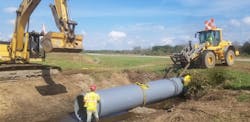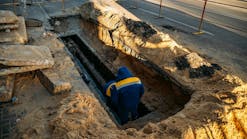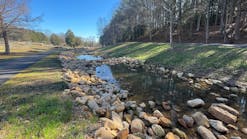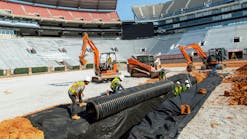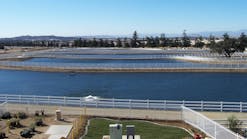Safety First
About the author:
Tori Durliat is director of marketing for Advanced Drainage Systems. Durliat can
be reached at [email protected] or 419.424.8275.
When it was discovered that the 60-in.-diameter storm water drainage pipe under the South Haven Area Regional Airport’s (LWA) main runway and taxiway was caving in, a new 300-ft pipeline had to be installed to save the paved area without impacting flight operations. Located near Lake Michigan and 20 miles north of Benton Harbor, Mich., the general aviation municipal airport has an average of 74 flights a day of mostly single-engine aircrafts. The main runway is paved and is 4,800 ft long and 75 ft wide. The other runway is a 3,300-ft-long turf runway.
Underground Obstacles
As with any airport regardless of size, flight operations and safety are the top priorities. Digging up the runway to put in a new culvert pipe not only was impractical but it would have been a major capital undertaking. Answering an invitation to bid, Compton Inc., a third-generation, local land improvement contractor, would slipline the old corrugated metal pipe (CMP) with a thermoplastic pipe.
“I went out and walked the job several times,” said Marc Compton, project manager. “We decided to bid and won the job. The old pipe was 60-in.-diameter corrugated metal pipe that ran for 277 ft on a diagonal of about 4 ft under the runway and taxiway. It is part of a county drainage ditch that is associated with a number of surrounding agricultural applications and outlets a little bit further down into Lake Michigan. We did not know when the metal pipe was installed, but our visual inspection revealed that it did not look like it was going to hold up and would continue to deteriorate. That was the purpose of this job—to remediate it and do it quickly because of the potential hazard of a runway collapse. The holes and gaps in the pipe would continue to allow soil to infiltrate and create voids under the runway."
Compton had to finish the job in 12 days. The contractor needed to meet Federal Aviation Administration regulations, and the project had to be rated for under runways. Compton decided to use 48-in.-diameter SaniTite HP pipe from Advanced Drainage Systems Inc. to slip into the old pipe. This smaller diameter would provide the space between the old and new pipe needed for grouting, but because of the new pipe’s smooth inner wall, the water flow would not be impacted but actually improved. To start, the crew flushed out and vacuumed the bottom of the pipe to get rid of any debris and sediment. During his original inspection, Compton found several deflections in the pipe’s ceiling.
“At first, we thought we might be able to get under them with the new pipe, but if not we had two contingency plans,” Compton said. “Number one and our first attempt was to use jacks to push the defections out of our way so we could slip the pipe through. That did not succeed because the bottom of the pipe was so badly rusted we did not have a good platform and the jack would punch through the bottom of the pipe before we could remediate the deflections on the top. We had to resort to taking in our saws and grinders, and we cut out the areas that were about 2 sq ft and picked out the material. We were going to be filling that angular area with grout anyway. After we cut them out, we immediately fed the pipe through in order to prevent any further collapse, and we grouted it a day or two later.”
Lessons Learned
The new pipe is made from an engineered grade of polypropylene resin, and is constructed with triple walls that give it the high degree of stiffness and beam strength needed for sliplining projects. The two gaskets and reinforced inline bell provide the watertight joint meeting ASTM D3212 requirements and the pipe meets or exceeds ASTM F2881 and AASHTO M330. For the new pipeline, nine 13-ft-long and eight 20-ft-long lengths
were used.
“We thought homing it together was easier than it would have been with any alternative type of pipe, which would have required come-a-longs and chains,” Compton said. “We did not have to do that in order to snap it together securely. And because of that, we really picked up on production and exceeded my estimate for the assembly.”
After the pipe was pushed into the old CMP, the space between the old and new pipe was filled using controlled low-strength material flowable fill grout. Grates were attached at each end.
“When I bid it I looked at other options,” Compton said. “It was not always going to be ADS SaniTite HP pipe from the get-go. It was after we assessed all the options that we knew it would be the best product for this application.”
